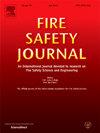The influence of vehicles on smoke propagation in transversely ventilated tunnels
IF 3.4
3区 工程技术
Q2 ENGINEERING, CIVIL
引用次数: 0
Abstract
We present an experimental study to assess the influence of realistic traffic conditions on the ventilation required to confine the smoke produced by a tunnel fire. The experiments are performed on a reduced-scale tunnel, with hot smoke modeled by a buoyant helium–air release. The tunnel is ventilated by two extraction vents placed on both sides of the source to confine the smoke, and a longitudinal flow is induced by a longitudinal pressure gradient. The traffic condition is simulated by arranging cubic blocks, representing vehicles, of two different sizes inside the tunnel. For each block size and various tunnel configurations (different damper geometries and positions, and the presence or absence of vertical barriers downstream of the vents), experiments are performed with and without longitudinal flow. The presence of vehicles can lead to outcomes that differ from the well-established results in the literature obtained in their absence, i.e., in an empty tunnel. Specifically, the performance of rectangular dampers becomes equivalent to that of squared-centered dampers unless vertical barriers are used. Furthermore, when barriers are employed, the geometry and position of the dampers become irrelevant to ventilation efficiency. Obstacles primarily affect ventilation efficiency when they interact with the buoyant smoke and change its stratification regime.
车辆对横向通风隧道烟气传播的影响
我们提出了一项实验研究,以评估实际交通条件对限制隧道火灾产生的烟雾所需的通风的影响。实验是在缩小尺寸的隧道中进行的,热烟是通过浮力氦-空气释放来模拟的。隧道的通风是由两个排烟口设置在源的两侧,以限制烟雾,并通过纵向压力梯度诱导纵向流动。通过在隧道内排列代表两种不同大小车辆的立方体块来模拟交通状况。对于每个块体尺寸和不同的隧道结构(不同的阻尼器几何形状和位置,以及通风口下游是否存在垂直障碍物),在有和没有纵向流动的情况下进行了实验。车辆的存在可能导致与文献中在没有车辆的情况下(即在空隧道中)得到的既定结果不同的结果。具体来说,除非使用垂直挡板,否则矩形阻尼器的性能与正方形中心阻尼器的性能相当。此外,当采用屏障时,阻尼器的几何形状和位置与通风效率无关。障碍物主要影响通风效率时,他们与浮力烟雾相互作用,并改变其分层状态。
本文章由计算机程序翻译,如有差异,请以英文原文为准。
求助全文
约1分钟内获得全文
求助全文
来源期刊

Fire Safety Journal
工程技术-材料科学:综合
CiteScore
5.70
自引率
9.70%
发文量
153
审稿时长
60 days
期刊介绍:
Fire Safety Journal is the leading publication dealing with all aspects of fire safety engineering. Its scope is purposefully wide, as it is deemed important to encourage papers from all sources within this multidisciplinary subject, thus providing a forum for its further development as a distinct engineering discipline. This is an essential step towards gaining a status equal to that enjoyed by the other engineering disciplines.
 求助内容:
求助内容: 应助结果提醒方式:
应助结果提醒方式:


